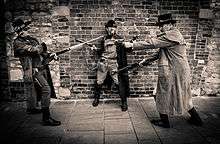Mexican standoff

A Mexican standoff is a confrontation between two or more parties in which no participant can proceed or retreat without being exposed to danger. As a result, all participants need to maintain the strategic tension, which remains unresolved until some outside event makes it possible to resolve it.
The Mexican standoff is a recurring trope in cinema, where several armed characters hold each other at gunpoint.
Etymology
The expression came into use during the last decade of the 19th century; the Cambridge Advanced Learner's Dictionary makes an unattributed claim that the term is of Australian origin. Other sources claim the reference is to the Mexican–American War or post-war Mexican bandits in the 19th century.[1]
The earliest print cite to the phrase was 19 March 1876 in a short story about Mexico, an American being held up by a Mexican bandit, and the outcome:
"Go-!" said he sternly then. "We will call it a stand-off, a Mexican stand-off, you lose your money, but you save your life!"[2][3]
Popular use
In popular use, the term "Mexican standoff" is sometimes used in reference to confrontations in which neither opponent appears to have a measurable advantage. Historically, commentators have used the term to reference the Soviet Union – United States nuclear confrontation during the Cold War, specifically the Cuban Missile Crisis of 1962. The key element that makes such situations "Mexican standoffs" is the equality of power exercised among the involved parties.[1] The inability of any particular party to advance its position safely is a condition common among all standoffs; in a "Mexican standoff," however, there is an additional disadvantage: no party has a safe way to withdraw from its position, thus making the standoff effectively permanent.
In financial circles, the Mexican standoff is typically used to connote a situation where one side wants something, a concession of some sort, and is offering nothing of value. When the other side sees no value in agreeing to any changes, they refuse to negotiate. Although both sides may benefit from the change, neither side can agree to adequate compensation for agreeing to the change, and nothing is accomplished.
A Mexican standoff where each party is pointing a gun at another is now considered a movie cliché, stemming from its frequent use as a plot device in cinema. A famous example of the trope is in Sergio Leone's 1966 Western The Good, The Bad and The Ugly, where three characters face each other at gunpoint.[4] Director Quentin Tarantino has featured Mexican standoff scenes in his films, including the climactic scene of Reservoir Dogs, which depicts a standoff between four characters.[5]
Resolution
In a confrontation among three armed and mutually hostile participants, the first to shoot is at a tactical disadvantage. If opponent A shoots opponent B, then while so occupied, opponent C can shoot A, thus winning the conflict. Since it is the second opponent to shoot that has the advantage, no one wants to go first. The situation further changes with the degree and type of armament each party possesses—a three-person Mexican standoff with dual-wielded pistols for each party skews the outcome in favor of whoever shoots first, with the presumption that both shots are fired simultaneously, as both opposing parties are eliminated.
See also
References
- 1 2 "Mexican standoff", The Word Detective, retrieved 2013-03-21
- ↑ Sunday Mercury (New York) (19 March 1876), p. 2, col. 5
- ↑ Sam Clements (2013-07-26). "antedating "Mexican standoff" (OED/HDAS 1891)". ads-l (Mailing list). Retrieved 2016-02-03.
- ↑ Jew, Anson (2013). Professional Storyboarding: Rules of Thumb. Taylor & Francis. p. 83. ISBN 1136126775.
- ↑ Bailey, Jason (2013). Pulp Fiction: The Complete Story of Quentin Tarantino's Masterpiece. Voyageur Press. p. 45. ISBN 9780760344798.
External links
| Look up mexican standoff in Wiktionary, the free dictionary. |